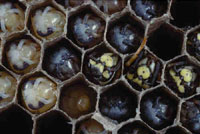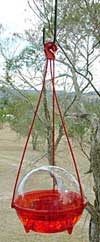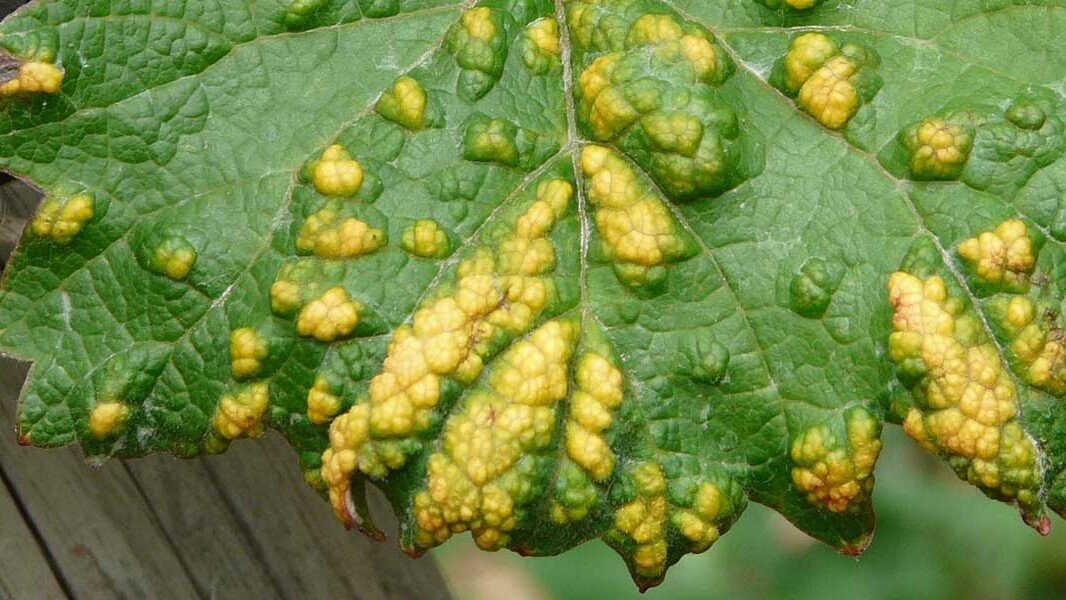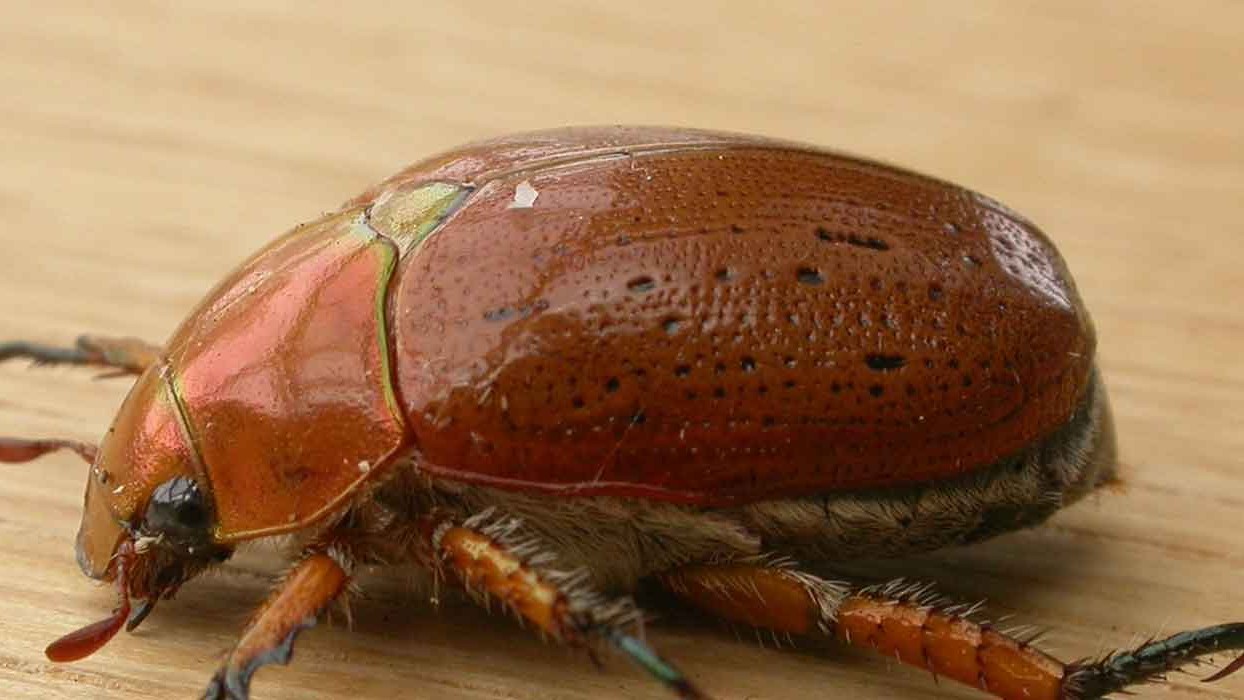(Vespula germanica and Vespula vulgaris)
These closely related wasps are the scourge of Australian gardeners and barbecuers alike, with the ability to inflict mighty painful stings repeatedly and a nasty temper to match.
The European wasp was originally from Europe, North Africa and temperate Asia, but it has now spread to North America, New Zealand, South Africa, and South America. It was first discovered in Sydney in 1954 when hibernating queens were found in a timber consignment from New Zealand.
It wasn’t until 1959 that nests were discovered in Hobart, then Sydney in 1975, Western Australia and Victoria in 1977 and then South Australia in 1978.
The English wasp first showed up Malvern, Victoria in 1958 and the nest was destroyed. Unfortunately more nests were found in 1960. Their distribution seems to be more restricted than that of the European wasp, but there isn’t much information on their spread. They are found in Victoria and southeastern Tasmania.
Life Cycle
Queens of both species spend the winter hibernating and emerge in spring to look for nesting sites. Nests are usually built underground, in holes dug in the soil, but as we know, they can be found anywhere there is protection from rain and moisture and warmth, such as inside cavity walls, woodstacks, tree trunks and even inside pots.
 The first batch of eggs laid are laid in a cluster of hexagonal cells made by the queen.
The first batch of eggs laid are laid in a cluster of hexagonal cells made by the queen.
Wasps make a type of paper by chewing wood fibre into a pulp. This is used as a protective layer over the cells, and on the outer covering of nests, which is cardboard like (as seen in the photograph here, courtesy of J.P.Spradbery, CSIRO Entomology).
 These first wasps are workers (sterile females) and take over the nest building work of the queen, leaving her to dedicate her time to egg-laying. The nest will be enlarged continually through summer and autumn.
These first wasps are workers (sterile females) and take over the nest building work of the queen, leaving her to dedicate her time to egg-laying. The nest will be enlarged continually through summer and autumn.
Each worker only lives several weeks, but there could be thousands present in a nest at any given time during summer and autumn.
Their defence of their nest is legendary. They are vicious. Vibration, rather than sound, alerts workers to an intruder, who come swarming out to attack. Once a victim is attacked, chemical cues guide more wasps to the attack.
Foraging by workers occurs within 50 to 250 metres of a nest. And they will collect just about anything that is carbohydrate or protein, including fruit, insects, and carrion. This is taken back to feed the larvae.
Towards the end of autumn the workers build larger larvae cells. These will host the next generation of several hundred queens and drones (fertile males).
During autumn the queens and drones indulge in mating flights, with the queens then seeking out winter sheltering sites. The males die off, as do the remaining nest occupants, although there are situations where enough food and warmth has ensured survival over winter. The next season these wasp nests have the ability to become absolutely enormous.

Chemical Control
We’ve all heard enough wasp stinging horror stories to know that this is one insect to treat seriously and carefully.
Chemical control of this wasp is very efficient but it needs to be carried out in a safety conscious manner.
The Museum of Victoria provides the following rules for the ‘Do It Yourself European Wasp Pest Exterminator’.
- Always treat the nest at night when wasp activity is low.
- Always cover your torch with red cellophane as insects cannot see red light.
- If possible, position the torch some distance from yourself, yet still illuminating the area to the treated.
- Always wear loose clothing, fully covering your body, a floppy hat or veil and gloves.
- Tell someone what you are doing and where you will be.
Above ground visible nests can be soaked with the spray of any commercially available insecticide.
 Nests in concealed, confined or restricted areas can be destroyed with a pest strip. Considering that up to 20% of wasp nests in Australia occur in roof spaces and wall cavities, this is a good solution. Simply place the pest strip near the nest. In a wall cavity, cut up the pest strip and pass it through outside air vents near the nest.
Nests in concealed, confined or restricted areas can be destroyed with a pest strip. Considering that up to 20% of wasp nests in Australia occur in roof spaces and wall cavities, this is a good solution. Simply place the pest strip near the nest. In a wall cavity, cut up the pest strip and pass it through outside air vents near the nest.
These areas can also be soaked with spray from an insecticide surface spray or the area liberally sprinkled with insecticide dust.
In ground nests can also be treated with dust. Do not apply if rain is likely within 24 hours.
In ground nests will require two applications several days apart to destroy.
Chemical baiting has been trialled in vineyards in the Yarra Valley and Mornington Peninsula areas of Victoria, with considerable success. Minced meat was laced with the insecticide. It was found quite effective in reducing wasp numbers in areas where it was very difficult to locate nests.
In these trials it was noted that even when wasp nests are totally destroyed by this manner, new wasps will move into the area.
Obviously extreme caution must be taken with this option, as pets could also eat the meat.
Other control methods
Sticky traps can be used to trap wasps and in Britain net traps are used to prevent wasps entering factories. Wasps are also attracted to ultraviolet light and electric traps.
 There are a variety of traps that allow entry but the wasp can’t exit. The success of these traps depends on the attractiveness of the bait.
There are a variety of traps that allow entry but the wasp can’t exit. The success of these traps depends on the attractiveness of the bait.
Sanitation (ensuring garbage is in containers with fitted lids for example, and removing food scraps as soon as possible), and proofing buildings against queens seeking nesting sites are also ways to reduce wasp activity.
Unfortunately, according to the researchers in this area, these wasps are here to stay. Total eradication is no longer an option. One upside is that despite their stinging ability, no deaths have been attributed to European or English wasps in Australia.
Information sources:
Kerruish, R.M. & Unger, P.W., 2003, 3rd Edition, Plant Protection 1, published by RootRot Press, ACT.
Museum Victoria
CSIRO
Banner image: Alvesgaspar [GFDL (http://www.gnu.org/copyleft/fdl.html) or CC BY-SA 3.0 (https://creativecommons.org/licenses/by-sa/3.0)], from Wikimedia Commons
Related Articles:
Prevent Pests in Your Garden
If you can prevent pests in your garden you will save time, resources and money as well as helping your garden flourish. Effective pest control is…
Christmas Beetles
Most of us would be familiar with the brightly coloured, glossy and sometimes iridescent Christmas beetles. We often see them dazed and confused,…



